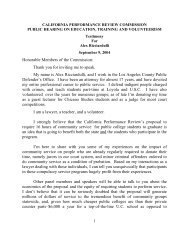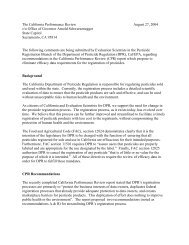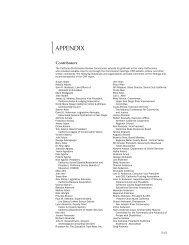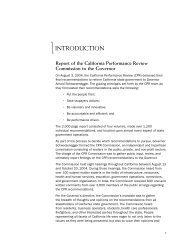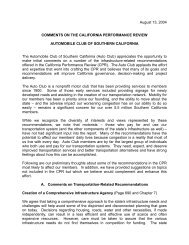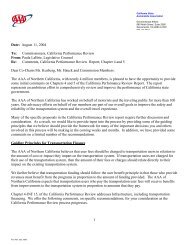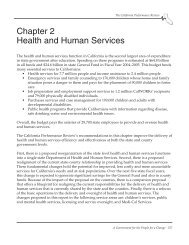Chapter 1 General Government - The California Performance Review
Chapter 1 General Government - The California Performance Review
Chapter 1 General Government - The California Performance Review
- No tags were found...
You also want an ePaper? Increase the reach of your titles
YUMPU automatically turns print PDFs into web optimized ePapers that Google loves.
<strong>The</strong> <strong>California</strong> <strong>Performance</strong> <strong>Review</strong>GG 09Establish a <strong>California</strong>Information CenterSummary<strong>California</strong>ns who wish to contact state agencies face a dizzying array of telephone numbersand websites. <strong>The</strong>re is no single point of contact, either by telephone or web portal, for<strong>California</strong>ns to access state information or services. <strong>California</strong> should establish a central<strong>California</strong> Information Center to offer information and services to <strong>California</strong>ns through asingle state toll-free telephone information number and a companion web portal.BackgroundIt is not easy for <strong>California</strong>ns to contact state government offices quickly and efficiently.According to MCI, one of the contractors for the state’s telephone services, there are more than1,400 toll-free telephone numbers operated by state agencies that use the contract. This numberdoes not include universities, local governments that use the state’s telephone contract, or stateagencies exempt from using the state’s contract. 1 Thousands of local telephone numbers forstate government also are in the “blue pages” of <strong>California</strong> telephone books and anundetermined, but presumably large, number of calls are handled outside the toll-free arena.<strong>The</strong> state has done little to assist the public in contacting state agencies, or to help the publicidentify which state agencies provide the services they need. <strong>The</strong> information that does existwas not planned and has never been coordinated. For example, the last edition of the<strong>California</strong> state telephone directory, which is almost four years old, has a section with listingsby agency or department and another section with an alphabetical listing of employees whochoose to be listed. A new directory will not be published until June 2004 and will cost stateagencies $10 per copy. With the state’s current budget problems, not all state agencies willorder them and many that do will likely order a minimal number.An online directory is available through the <strong>California</strong> web portal (www.ca.gov). <strong>The</strong>re is noeasy way to navigate to it and there is generally no link to it from most state websites. Like thestate telephone directory, it lacks any listing organized by services or areas of interest. <strong>The</strong>agency index simply directs the user to the agency website, which often has no telephonecontact information. <strong>The</strong> employee index offers users the ability to find telephone numbers forspecific employees, but, there is no indication which employee should be contacted forquestions about specific programs or services.<strong>California</strong> has four state operators who work from 8 a.m. to 5 p.m. Monday through Friday,excluding holidays. <strong>The</strong> number for the state operator is listed in many major telephonedirectories. Operators take between 700 and 1,000 calls per day on a wide variety of topics,A <strong>Government</strong> for the People for a Change 51



